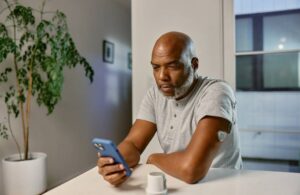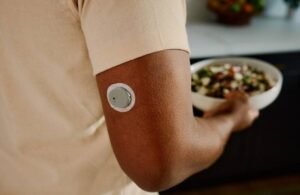How Dexcom designed a new ‘life-changing’ sensor for even more people with diabetes
How Dexcom designed a new ‘life-changing’ sensor for even more people with diabetes Sean Whooley

Dexcom (Nasdaq:DXCM) Chair, President and CEO Kevin Sayer says that, in 2019, he gave a speech announcing the company’s first $1 billion year. This week, Sayer announced the continuous glucose monitor maker’s first $1 billion quarter.
Plenty of innovation has bolstered that progress over the past few years. Nearly one year ago, Dexcom launched its next-generation G7 CGM. Last month, the company announced new integrations with automated insulin delivery systems from Tandem and Beta Bionics.
Now, the company can expect even more growth, thanks to its next major product launch.
Dexcom announced that it submitted its new sensor, Stelo, to the FDA for review. The company expects to launch Stelo, which is designed for people with type 2 diabetes who don’t use insulin, this coming summer.
“Our mission is to empower people to control health and this is the first step along that journey,” Sayer told Drug Delivery Business News. “We’ll always be very active in the insulin-using world. That is our core business. Those are our core customers and, really, the people that have gone with us this on this journey. We’re never going to abandon that.
“We’ll continue to advance and enhance our technologies here but we just think glucose can be such a vital sign for other people wanting to control their health.”
How Dexcom developed and designed Stelo
At the company’s June Investor Day event, it revealed its plans to bring the new product to market in the U.S. in 2024. According to Dexcom, the target population includes approximately 70% of Americans with diabetes.
Dexcom finally unveiled the Stelo device, designed with a 15-day wear with a cash-pay option. It features a software experience tailored specifically for non-insulin users. The device won’t “bother” users with the alerts and alarms geared toward insulin users, Sayer said. Rather, it just offers the insights that users desire.
Stelo exists on the current G7 platform, so Sayer said manufacturing is already in place on the current lines the company has. He also believes the company should get reimbursement for the device over time and create a class of products for the target population.
“People with type 2 diabetes, they want to control their lives,” Sayer explained. “They want to control their health. They’re afraid of the complications of diabetes and don’t want to migrate to all the other drugs. … We think, by offering a product that’s geared for them … we’re creating an experience that can really help them optimize their health.”
The device’s 15-day wear improves upon the G7 platform’s 10-day wear. Sayer explained that the company believes that, in this patient population, the technology can last over a longer period of time. Still, because it’s built on the proven G7 platform, it offers the known reliability and quality standards, he added.

Additionally, Dexcom modified the software interface and in-app experience to gear Stelo toward the individuals using it. That includes easier warmup time because there’s no need to configure alarms or alerts.
“This isn’t a life-saving device,” Sayer said. “In this market, it’s more of a life-changing device. It’s more of a ‘manage your healthcare device.'”
Progress for G7 and Dexcom One
Since rolling out the G7 last year, Sayer said the majority of the device’s users are new individuals in need of a CGM.
The company has also seen “a lot” of conversion from G6 users, but Sayer highlighted the automated insulin delivery connectivity roadblock. Tandem and Beta Bionics only just announced full integration, so pump users haven’t quite migrated over to the G7 yet.
“So we’re seeing the Tandem users starting to convert, but it’ll take a while,” Sayer said. “They’re having good outcomes with their G6 sensors. Customers are going to use up their existing inventories before they switch to a new one. Insurance companies make you do that too, but we’ll see that switch. the people that have switched have been wildly happy so this will be fine.”
Another area where G7 will expand is in the Dexcom One offering. Sayer said the platform will transfer from G6 to G7 in the first quarter of 2024.
Dexcom One continuously monitors glucose levels in real-time, sending values wirelessly to a compatible smart device through the app or receiver, which then displays trend arrows to show the speed and direction that glucose levels are heading. It also has a range of customizable alerts and access to the Clarity data management software to provide remote data sharing with healthcare providers.
The platform enables Dexcom to compete in a “lower-risk tier,” a segment of customers who don’t need to share data with others. It’s available in a number of geographies, including France and the UK. The system launched in a handful of European countries at the end of 2021. It’s available in Bulgaria, Latvia, Estonia and Lithuania, too.
“This portfolio strategy has allowed us to get access to 4 million more people to CGM in these international markets over the past two years and that is a very big access expansion for us,” Sayer said.
More on CGM-automated insulin delivery integration
In October, Dexcom COO Jake Leach explained the company’s strategy for automated insulin delivery (AID) integration.
“We’ve prioritized connectivity for more than a decade, which means our CGM systems are optimized to seamlessly connect with insulin delivery and digital health partners of all kinds, giving users freedom of choice in their diabetes journey and making Dexcom the clear choice for AID,” Leach told Drug Delivery Business News.
Just two months later, the company had major developments on that front with its integration with Tandem and Beta Bionics. While its previous-generation G6 had been the go-to CGM for automated insulin delivery, these two companies became the first to integrate the next-generation G7.
Sayer said that Insulet, which uses G6 for its Omnipod 5, expects to integrate G7 within this calendar year. More partners are on the horizon, too, he said.
“We continue to talk to others where it makes sense,” Sayer said. “Our connectivity remains a core feature.”
Dexcom also filed with the FDA to bring a direct-to-watch control feature to bring it to market this year. It enables people to control their device from a smartwatch, smartphone or the insulin pump itself with all three synced up.
This could offer more options to, for example, parents who may not want their kids taking a phone to school because they’re young. They can wear an Apple Watch instead and get all their data that way. Athletes who don’t want to take their phone on a run can track data on their watch, too.
“We’re really proud to have filed that,” Sayer said. “We know that’s a big feature for our users.”
Sayer says the ultimate goal is to give people the choice and let them choose the best product. This makes Dexcom’s mission very simple, he explained — “you’ve got to be the best.”
“It’s a collective goal, it is a complicated goal,” Sayer said. “We’re really happy with what we’ve learned so far. And we’ve got a bunch of great innovation scheduled for the future.”
The post How Dexcom designed a new ‘life-changing’ sensor for even more people with diabetes appeared first on Drug Delivery Business.